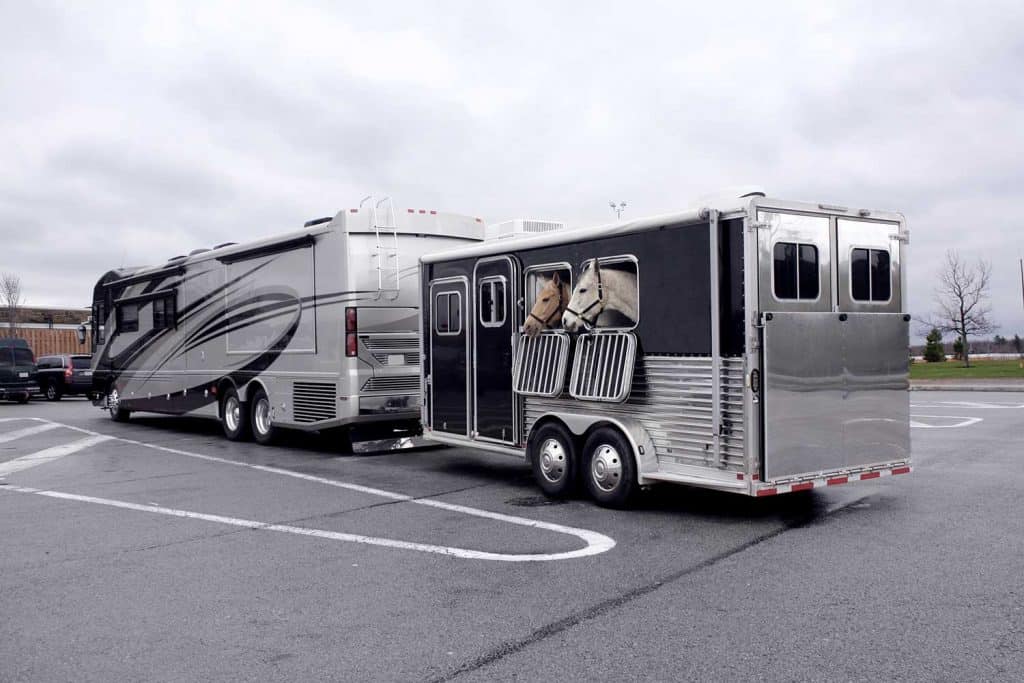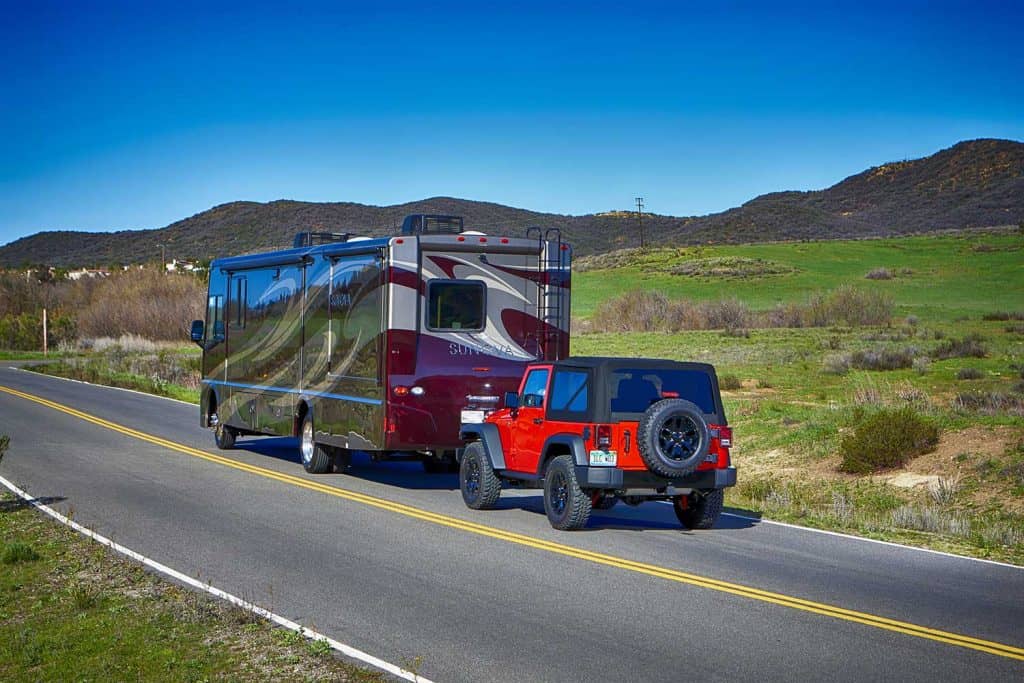Class C Motorhomes are made by many different manufacturers and constructed in many different ways. This wide variety also means there is a wide range of capability, with lengths between 21 to 41 feet and lots of engine options class C's are not a one-size-fits-all when it comes to towing. We've researched what a class C motorhome can tow, so you'll know what you can hitch up when ready for exploration.
A class C motorhome can tow between 3,500-lbs to as much as 40,000-lbs depending on the motorhome's amenities, chassis, and engine. To give an idea of the most common towing capacity range for class C's, a typical standard vehicle weighs approximately 8,000-lbs. Several chassis options include Ford E350/E450, Chevy Express, Ford Transit, Mercedes cutaway chassis, or the Super C Motorhome sporting Ford's F550; this is to name a few, but it is not an exclusive list.
We spent hours finding the answers to crucial questions, like how to determine maximum towing capacity for your class C motorhome. We'll also discuss whether class C's can tow cars, boats, and horse trailers. Finally, we'll give you some towing tips, such as whether a tow bar, dolly, or car carrier are best for your rig. Soon, you'll know exactly what you can take along for your extended travels. Sit back and enjoy the read!

Different Classes of Motorhomes
To understand a Class C motorhome, you must first understand what class A and class B motorhomes are. While they may all look similar, there are subtle and blatantly apparent differences.
Class A Motorhome
Class A motorhomes are built on a chassis similar to a large bus, 18-wheeler, or sometimes a commercial vehicle frame. The frame is heavy-duty and thus makes for terrible gas mileage ranging from 8-10 MPG, if not worse. The average sleep occupancy ranges from two to four persons. The amenities include a full bathroom, kitchen, dining room, sleeping areas, a kitchen table that can sometimes double as a bed, and the driving area; these motorhomes customarily come with two (2) slideouts.
The towing capacity for a gas class A motorhome usually sits around 5,000-lbs. However, diesel class A motorhomes can have a range of towing capacity of 10,000 to upwards of 15,000-lbs. Keep in mind that the length of a class A motorhome ranges from 29 to 40 feet, so adding any additional tow length to that could be quite the haul.
Class B Motorhome
Class B motorhomes resemble a large van. They can range from 18 to 24 feet in length. If you are tall, you can still comfortably stand up in a standard class B motorhome. If you are short, you can comfortably fit just about anywhere in the motorhome. The amenities include a kitchen, bathroom - where the shower and toilet are often combined, a very tiny dining room/living room area, sleeping quarters, and a driving area. Class B motorhomes have minimal storage due to their smaller size. However, if parking gives you anxiety, this will ease your nerves.

Four is the average number of people that most class B motorhomes can fit. Some can sleep five, but that's uncommon. As far as towing goes, the most a class B can tow is around 3,500 to 5,000-lbs. Keep in mind the class B is smaller than class A motorhomes; therefore, the towing capacity is significantly reduced when the motorhome is loaded with all the amenities.
Class C Motorhome
Class C motorhomes are in-between class A and class B motorhomes. Class C motorhomes have cabin chassis, which enables a sleeping area above the vehicle's cab. They typically have at least one (1) slideout feature. The amenities include the kitchen, bathroom - the smaller ones combine the toilet and shower, dining room/living room area, multiple sleeping options, and the driving areas.
Depending on the brand, make, and model, class C motorhomes can sleep as many as 11 or as little as 6. Class C motorhomes range from 21 to 41 feet in length. The average towing capacity ranges from 3,500 to 8,000-lbs. However, there are super class C motorhomes that have an engine similar to an 18-wheeler, enabling a towing capacity of 40,000-lbs! With that kind of towing capacity, it may feel like a boatload of feathers behind your oversized vehicle. Even with trailer brakes, when hauling anything, it's better to leave more space than needed just in case!
How to determine Maximum Towing Capacity
Trying to figure out the maximum towing capacity when you're new to hauling anything can be frustrating. The difference between payload, gross vehicle weight, gross combined weight, gross trailer weight, tongue weight, curb weight, and dry weight is downright daunting. For towing purposes, you want to check the following:
- Gross vehicle weight
- Gross trailer weight
- Gross combined weight
Most vehicles have a sticker on the door or the inside frame of the driver's side door that tells the operator what weight is allowed for a combined gross vehicle and trailer weight. Your vehicle and trailer's combined weight cannot exceed the gross combined weight listed on the door. If the combined weight exceeds the listed weight, that would be unsafe to tow.
Can a Class C motorhome tow a boat?
Pending that your boat is on a trailer, there shouldn't be an issue with towing your boat with a Class C motorhome. Boat trailers, as a general rule, are tow-behind/bumper pull trailers. This enables you to pull with any vehicle that has a receiver and the right size ball. However, boats can weigh 100-lbs to 5,000-lbs or more.
Keep in mind when hauling a boat that the empty trailer weight is in addition to the boat weight. Fishing equipment isn't necessarily hefty. If you add over 500-lbs of gear to your 3,500-lb boat and have a 1,000-lb trailer, that's 5,000-lbs. If your class C motorhome can only haul 5,000-lbs, it can be taxing on an engine and transmission to pull the total max weight for long periods.
However, as long as the boat is within your maximum towing capacity, there is little to no reason that a class C motorhome cannot tow a boat.
Can a class C motorhome tow a horse trailer?
Horse trailers come in two varieties, a gooseneck or a bumper pull/tow-behind. A gooseneck hitch is similar to a fifth wheel hitch in that the hitch gets mounted into the truck's bed. A gooseneck and fifth wheel are subtly different. The gooseneck has a ball that is either mounted in the truck's bed or mounted on a rack installed into the truck's bed rails.
A tow-behind trailer's hitch is below a truck's back bumper. A receiver with a ball gets placed into the hitch, and the trailer is lowered onto the ball. A class C motorhome can be equipped with a hitch to enable a receiver and ball to be connected. If the motorhome didn't come with one, most mechanics could install a traditional ball and hitch onto the vehicle.

Horse trailers vary from steel versus aluminum or a combination of both. The weights can be a little as 1,200-lbs to over 9,000-lbs empty weight. Once you add horses, hay, water, and equipment, that number keeps adding up. Bumper pull aluminum trailers for two (2) horses would easily weigh 2,400 to 3,200-lbs without the animals and gear.
Towing a bumper pull horse trailer with a class C motorhome is 100% possible. Knowing your maximum towing capacity is imperative when determining which engine you will need with your class C motorhome to comfortably tow your horses.
It's equally important if you already own a class C motorhome to look at your towing capacity and compare it with your horse trailer's empty weight. If the motorhome's gross combined weight and the empty trailer are close, you have to remember the animals' weight and all the gear that will be added.
Can you tow a car with a Class C motorhome?
Like anything in this life, it boils down to how big your engine is. A smaller vehicle like a Honda could weigh around 2,000-lbs. A smaller SUV could weigh 3,000-lbs. Lastly, a truck weighs between 3,900-lbs to over 6,000-lbs.

Generally speaking, your class C motorhome should have a big enough engine to haul at least the average 3,500-lb car. The make, model, and type of vehicle you're towing has a noticeable impact on how much towing capacity you need. If you are hauling a full-size pickup truck, you will need to be able to haul upwards of 4,000 or 5,000-lbs. If you are pulling a sedan, the need for hauling over 4,000-lbs diminishes.
Is a tow dolly or car carrier better?
To determine if a tow dolly or car carrier is better, we need to examine the differences. A tow dolly is a bumper pull style trailer that has two wheels. The tow dolly then lifts your vehicle's front wheels off the ground, and the back wheels remain grounded. A car carrier is a bumper pull styled four-wheeled trailer that puts your vehicle on top of putting all the vehicles’ weight on the trailer.
Front and rear-wheel drive vehicles have different weight distributions. Since front-wheel-drive cars carry the engine's weight on the drive wheels, and the drive wheels need to be supported on the dolly, your total vehicle weight must be less than 3,500-lbs for most dollies to handle safely. A rear-wheel-drive vehicle, however, requires the rear wheels be supported by the dolly, which lightens the load the dolly needs to support; the weight of the engine is no longer a factor. This means you can safely tow a vehicle between 3,900 and 4,200-lbs.
The towing capacity varies depending on the make, model, and weight capacity of the individual towing dolly. Some companies will rent tow dollies, so purchasing is not always necessary if you don't intend to use the dolly more than a handful of times. A tow dolly is typically less expensive to rent or buy than a car carrier. They are great for shorter distances and smaller vehicles.
A car carrier is designed to hold more weight than a tow dolly. Car carriers can hold up to nearly 5,300-lbs. There are larger car carriers that can accommodate additional weight. However, the average truck weight is roughly 4,000-lbs.
In comparison, a standard car or small SUV is around 3,500-lbs. A car carrier with a max gross weight of 7,500-lbs, with the trailer's empty weight around 2,200-lbs, is sufficient for hauling most vehicles.
When deciding on a car carrier or a tow dolly, there are a few factors to consider. A tow dolly takes your vehicles partly off the ground, but not entirely. With a tow dolly, you are still putting mileage and wear and tear on your overall vehicle. The towed vehicle can sometimes have clearance issues, resulting in damage to the towed vehicle's undercarriage or bumper parts.
A car carrier is more expensive to rent or buy but has some great features if you're looking for a long term vehicle hauling option. Your entire vehicle is on the car carrier entirely off the ground resulting in no additional mileage or wear and tear to your towed vehicle. A car carrier is more straightforward to back up than a tow dolly and is less likely to have sway issues.
On the other hand, the car carrier is more expensive to rent or buy. The car carrier has a heavier empty weight at 2,200-lbs versus the tow dolly at 750-lbs. The engine in your class C motorhome may very well decide if it cannot tow the necessary weight that the car carrier adds.
Summary
Towing with anything can take time and practice. Towing with a 30-foot trailer can be even more trying. The reward of taking horses, a boat, or a smaller vehicle along is well worth the hassle. It’s never a bad idea to consult with the manufacturer or the owner’s manual of your class C motorhome if you’re not sure how much weight it can tow. Happy hauling!
